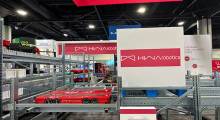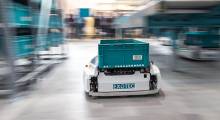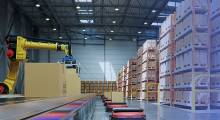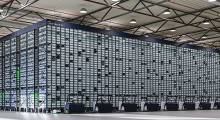Since the Industrial Revolution, humans have worked alongside machines to manufacture products faster, more efficiently, and with higher quality each passing year. Over time, those machines have become more sophisticated, electrified, now digitized, and exploding in numbers as technology costs go down and the scale of business goes up.
Not only do assistive digital machines now outnumber workers, but they also work at a scale beyond anything humans can do. This revolution in automation is acute in both large scale warehouses and micro-fulfillment centers.
A new revolution in automation technology has arrived: the rapid adoption of 3-dimensional automated storage and retrieval system (ASRS) machines.
Every revolution requires attentive preparation with a competitive and survival mindset for those that want to win in the new environment. Despite torrid 3D ASRS adoption, many operators have not prepared for several looming down-the-road risks that might cause significant re-engineering, if not the failure of needed efficiency gains.
Without careful preparation, operators will find it nearly impossible to manage unpredictable scale and throughput, achieve critical energy management for sustainability, and implement required smart data management for critical reliability over time.
Where did this problem and new risks come from?
We all know e-commerce has taken center stage for retail and transformed our entire supply chain. The pandemic era surge caused a 14% year-over-year growth in 2021 and another 8% in 2022 with e-commerce reaching $1 trillion for the first time.
This dramatic market transition comes with a perfect storm of factors such as a tight labor market and increased expectations for faster (if not same-day) delivery.
Plus inflation pressures for inventory carry and operating costs. All of this, in addition to the new mega-scale required to meet throughput demands and competitive efficiencies, requires a radical quickening of automation technology adoption.
Change has been afoot for a while with the transition from basic autonomous mobile robots (AMRs) to 3D AS/AR systems. Mobile robots have been used extensively for the past ten years and will continue to be used in many applications for years to come.
But ASRS systems provide a comprehensive solution to automate the entire flow of goods from arrival to storage, retrieval, picking, and packaging. All in a way that has not been previously possible.
Before getting into the new technical challenges, let’s review the benefits of the current generation of systems:
- Reduced warehouse space – 3-Dimensional ASRS takes advantage of a building’s height, packing more goods into a smaller footprint to maximize “cubic utilization.”
- Micro-fulfillment locations – new warehouses no longer require acres of open land, allowing them to move into urban areas where they are closer to customers for faster delivery.
- Increased worker productivity – by eliminating the most mundane picking and sorting tasks these systems help improve employee retention.
- Increased throughput – better order accuracy using robot/computer inventory tracking and management tools.
- Energy efficiency – less space to heat and cool means lower utility bills and better management of perishable goods.
Next-gen thinking for the next generation of ASRS
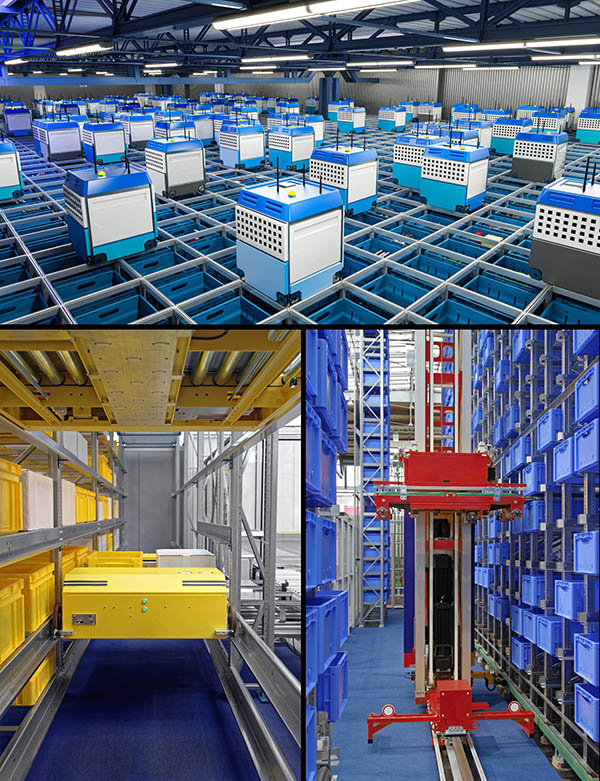
Efficiency and throughput gains from 3D ASRS systems are well documented. A recent review of case studies by the Materials Handling Institute indicates storage utilization increases of more than 50% and labor-per-pick reductions of 70% or more.
To reach this level of efficiency, systems operate with extremely high throughput, using hundreds of onboard robots or shuttles, each of which may contain conveyors, sensors, motor controllers, onboard power such as batteries or supercapacitors, and more.
These devices not only need power, they need lots of it provided consistently. And they often require wireless control communications to operate in harmony.
Watching an ASRS system in action is to witness a symphony of devices receiving power and data at just the right time, hundreds if not thousands of times per hour.
Still striving to prepare for the future, the systems we now see in the design and initial deployment stage will give operators an order of magnitude more scale – and complexity to go with it.
So, if we want to capture all the benefits above, our industry must consider several inherent problems with scale. We see three risk areas that are critical to the next generation of systems: energy delivery and management, fleet-wide control and data transmission for scale and growth, and overall system visibility and monitoring for real-time operational excellence.
Energy delivery and management for high reliability and efficiency
Reliably powering thousands of shuttles moving throughout an ASRS machine can be a challenge. Until recently, the only viable solution for ASRS manufacturers was some form of physical electrical contacts.
Either the track itself was energized or the shuttle approached specific points within the machine for charging. In both cases, however, brushes or spring-mounted contact points were required to send energy from the source to the shuttle.
As one can imagine, this method can be problematic. In machines with a high frequency of power delivery cycles, the contact points will rapidly wear and become less reliable
It’s also easy for contacts to bend or break due to the high-speed environment. In a worst-case scenario, the contacts become a safety concern due to short-circuiting or overheating.
And, of course, systems with permanently energized tracks must be completely shut down before any human maintenance can begin. Add any sort of dust or moisture to the environment and problems become magnified.
Finally, unless the energy delivery system is paired with data, we never really know the quality of charge nor the health of the device through immeasurable charge cycles.
Fortunately, wireless power technology now offers a simpler, safer solution. Whether acting as a battery charger or simply as an instantaneous wireless power supply, today’s systems can deliver power to the device wirelessly.
They require no contact, so there are no wearable parts. Adaptive wireless power systems are also very forgiving of misalignment or variable charging distances within a machine. If the shuttle stops a centimeter or two shy of its target, highly efficient power transfer is still possible.
Even when hundreds of thousands of power delivery cycles are required within the lifespan of a high-quality wireless power system, monitoring and device health can be managed. Fleet battery life optimization becomes possible and gives every company a way to advance sustainability.
Eventually, batteries need to be replaced, which can require frequent and expensive maintenance – so with careful energy monitoring and management, batteries can last more than twice as long. This saves tremendous labor and disrupts the waste stream of many thousands of toxic batteries. It’s a win-win operationally and for the planet.
Fleet-wide control and data transmission for scale and growth
Overlooked in the prior generation, AMR and ASRS infrastructure is what happens to data in high-scale and now mega-scale NextGen deployments.
We all thought WiFi was going to be enough, but it turns out that receiving data from sensors and sending commands to conveyors, sensors, cameras, and any other powered devices onboard robots is a significant challenge.
A single ASRS system can have hundreds of shuttles and thousands of sensors. Each time a shuttle moves, picks up, or discharges a package, multiple commands must be sent. The amount of wireless data traffic is staggering.
With an enormous number of these devices operating simultaneously in a large warehouse, WiFi networks are quickly saturated by the sheer volume of data.
Here again, wireless power systems offer a unique solution. High-quality adaptive wireless power systems incorporate RF communication links that operate separately from the power link.
This link monitors the power transfer process and adapts it to sudden changes such as movement or load changes during power transfer.
But this wireless data link also provides a separate channel for control data that is unaffected by more traditional wireless networks.
The best ASRS systems, whether wired or wireless, need high-reliability data links designed in from the start. Otherwise, the problems that can manifest after reaching scale may require a significant re-design of hardware and controls infrastructure.
Good wireless power systems offer just such a robust and low-latency alternative by incorporating data over the fundamental wireless power frequency or by using non-WIFI data communications protocols that are less susceptible to interference.
System visibility and monitoring for real-time operational excellence
Like any increasingly digital environment, NextGen warehousing systems must be designed with a software mindset and architecture from the start.
Reliable throughput and failure avoidance across mechanical, electrical, and software vectors require a smart software platform to sense physical activity and operating parameters.
Essentially, NextGen systems need to operate as a self-contained and managed system within the overall warehouse system.
Forward-looking designs must be ready to monitor the health of the entire robot/shuttle fleet and all power locations. Where batteries are used, this provides the possibility of increased battery longevity through choreographed charge scheduling.
This decreases battery replacement costs, intervention labor, and downstream waste. Where power is delivered only momentarily to the device, it’s important to know that the proper voltage and current is delivered reliably, how quickly it is delivered, and whether the load devices has responded as expected.
In short, wireless power combined with data transmission and collection is uniquely positioned to help a growing community of robotic fleet optimization managers confidently meet uptime and throughput KPI’s.
Next-gen ASRS systems as a strategic asset
It’s early days for ASRS, yet it’s already proven incredibly successful. Companies are actively investing in them to optimize for reliability, cost, safety, and productivity.
Combined wireless power and data systems now provide ASRS manufacturers and operators alike a highly reliable alternative to electrical contacts for both power and data.
Warehousing and logistics leaders looking to advance their business into the next mega-scale era of e-commerce must plan for their robotics systems to be more than isolated cogs in the big machines.
Taking a planful ecosystem approach with embedded energy management, data management, and smart platform management dramatically improves system ROI and sustainability goals.
The future is wireless.
About the author

Ben Waters, Ph.D., is co-founder and CEO of WiBotic. WiBotic provides fleet data management software and wireless charging platforms for the rapidly growing automation ecosystem.
WiBotic solutions help companies optimize the uptime of robot fleets and are an integral component of fully autonomous robotic operations.
Article topics
Email Sign Up





